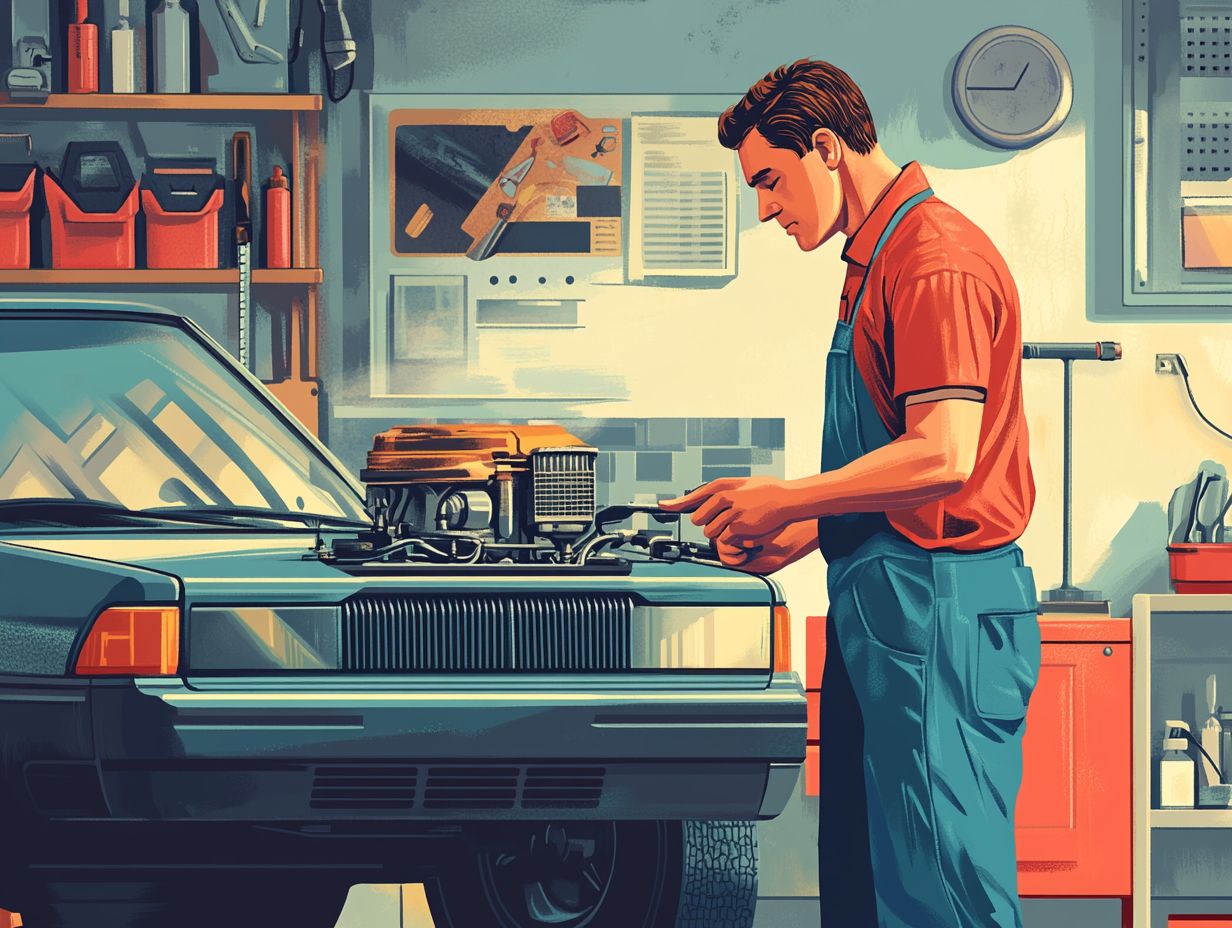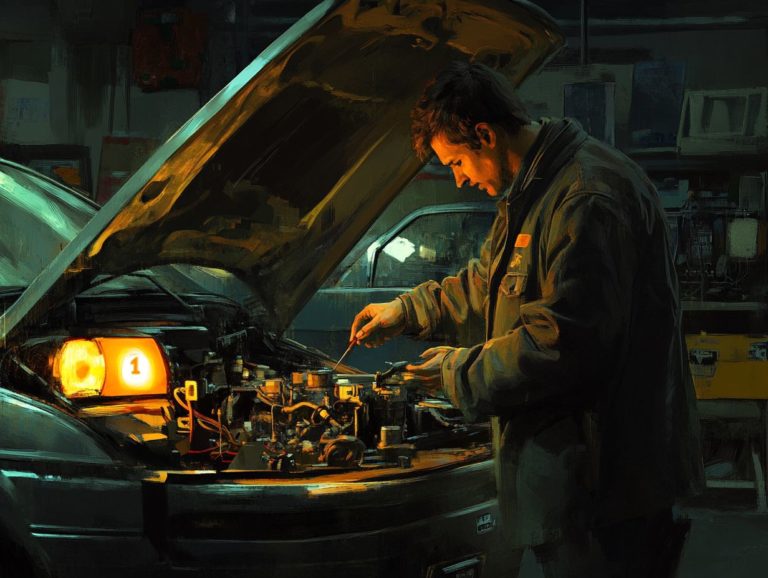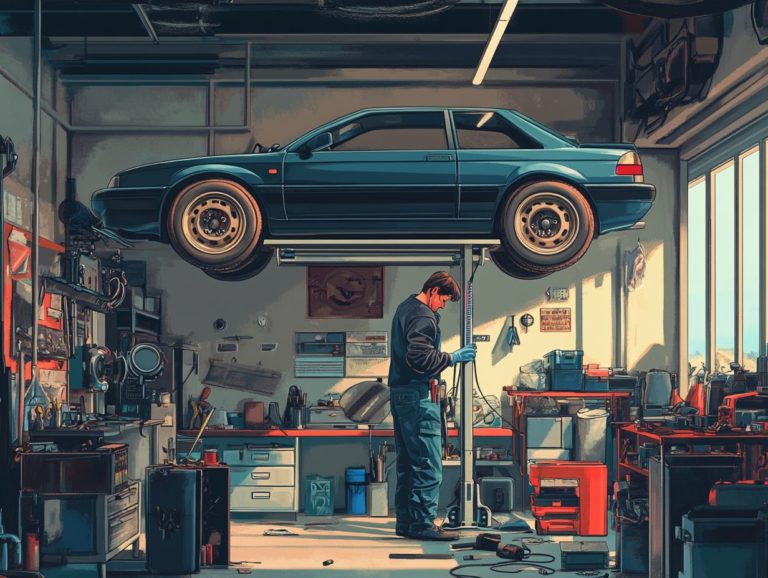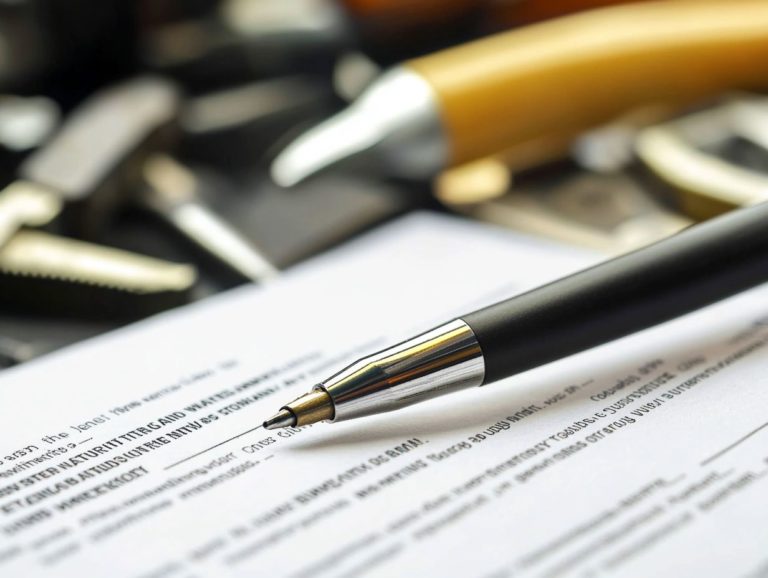How to Maintain Your Car’s Cooling System
Your car’s cooling system is vital for ensuring your engine operates smoothly and stays cool. With multiple components working in harmony, it s essential for you to grasp how each part functions and why regular maintenance is critical.
This guide will empower you to recognize signs of cooling system issues, outline a recommended maintenance schedule, and provide a detailed DIY approach for flushing and refilling coolant.
Whether you re a seasoned car enthusiast or a first-time owner, you ll discover valuable tips to keep your vehicle in peak condition.
Contents
- Key Takeaways:
- Understanding Your Car’s Cooling System
- Signs of Cooling System Problems
- Regular Maintenance for Your Cooling System
- DIY Cooling System Maintenance
- Professional Cooling System Maintenance
- Tips for Maintaining Your Cooling System
- Frequently Asked Questions
- What is a car’s cooling system and why is it important to maintain?
- How often should I check and maintain my car’s cooling system?
- What are some warning signs that my car’s cooling system needs maintenance?
- What are the steps involved in maintaining a car’s cooling system?
- Can I maintain my car’s cooling system myself or should I take it to a mechanic?
- How can regular maintenance of my car’s cooling system save me money in the long run?
Key Takeaways:
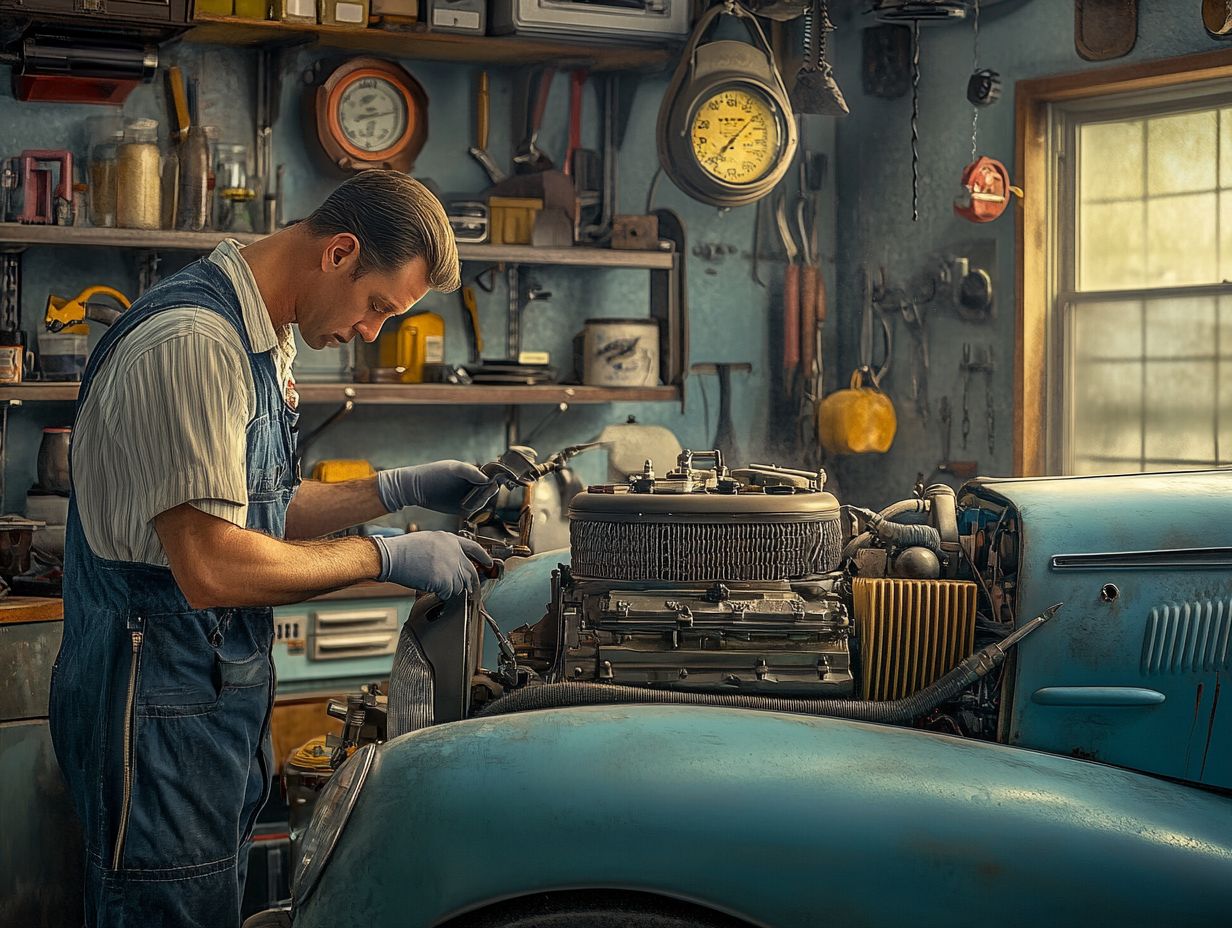
- Regular maintenance keeps your cooling system functioning well and saves you money.
- Pay attention to warning signs of issues, such as overheating or leaks, and address them promptly to prevent further damage.
- Whether you choose to DIY or seek professional help, following a recommended maintenance schedule and taking preventive measures can significantly extend the lifespan of your cooling system.
Understanding Your Car’s Cooling System
Understanding your car’s cooling system is crucial for maintaining the best engine performance and avoiding costly repairs. Knowing what to know about engine coolant maintenance is essential in regulating engine temperature and stopping overheating to ensure your vehicle’s longevity.
Key components like the radiator, water pump, and hoses each play a significant role in the system’s efficiency. Regular maintenance, such as checking coolant levels (the liquid that helps keep your engine cool) and flushing the system, can help you steer clear of serious issues like leaks or overheating. Additionally, understanding how to maintain your car’s transmission is crucial for overall vehicle performance.
With the right care, you can boost your car’s performance and extend its lifespan, making it vital to grasp how each part works in harmony.
Components of the Cooling System
The cooling system of your vehicle is made up of several key components, each one essential for maintaining optimal engine temperature and performance. The radiator works diligently to dissipate heat from the coolant, while the water pump circulates this coolant throughout the engine and system.
Hoses and belts ensure that fluids move seamlessly, and the pressure cap plays a vital role in maintaining system integrity. To prevent overheating and subsequent engine damage, it’s crucial to regularly inspect and maintain each of these components.
Proper coolant and antifreeze (a substance mixed with coolant to prevent freezing) mixtures are equally important; they not only help regulate temperature but also guard against corrosion and freezing.
If your coolant levels are low or the mixture isn’t right, the efficiency of the system can take a hit, leading to potential failures. By understanding these components and their functions, you can ensure your vehicle remains in peak condition, protecting both its performance and longevity.
Importance of Proper Maintenance
Properly maintaining your car’s cooling system is crucial not just for optimal performance but also for preventing overheating and potential engine damage. Learning how to maintain your car’s cooling system through regular checks and services allows you to identify leaks, inspect hoses and belts, and ensure coolant levels are just right.
This vigilance ultimately extends the life of your vehicle. By routinely flushing the cooling system, you can eliminate the buildup of debris and contaminants, enhancing efficiency and reducing the risk of blockages.
It s vital to keep an eye on those coolant levels; low levels can lead to insufficient cooling, increasing the chance of overheating. Don t wait until it s too late act now to keep your car running smoothly!
Professionals recommend scheduling an annual service to thoroughly assess the entire cooling system. Neglecting these maintenance tasks could lead to significant engine damage, potentially costing you thousands in repairs. Proactive care doesn t just preserve your engine’s integrity; it also guarantees a safe and reliable driving experience.
Signs of Cooling System Problems
Recognizing the early signs of cooling system issues can spare you from costly repairs and prolonged vehicle downtime. Watch for these warning signs to protect your car and wallet!
- Fluctuations in the temperature gauge
- Engine overheating
- Visible leaks beneath your vehicle
- Any unusual sounds emanating from the engine compartment
Being attuned to these symptoms serves as your first line of defense in safeguarding your car’s health.
Identifying Warning Signs
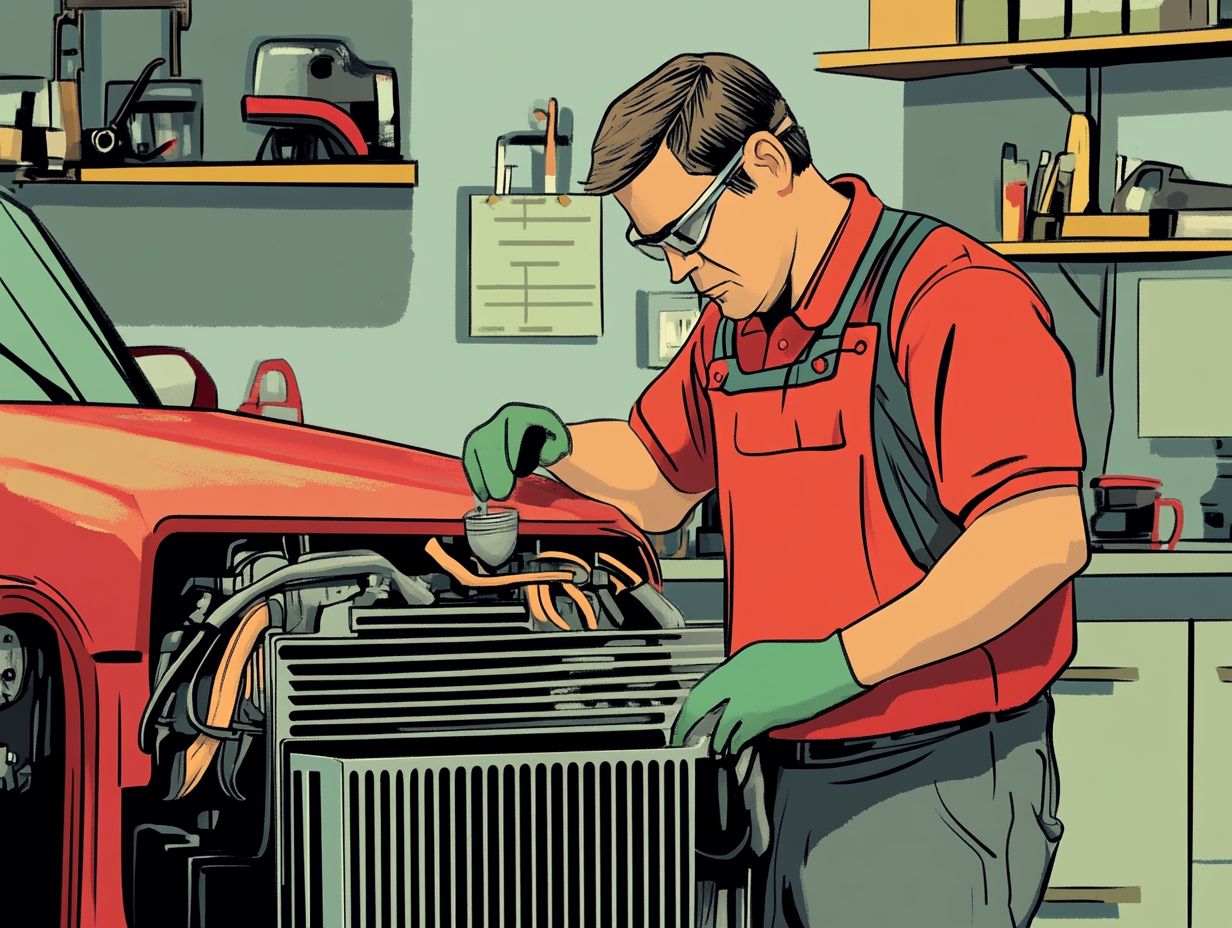
Identifying the warning signs of cooling system failure is essential for preventing serious damage to your vehicle’s engine. You should keep an eye out for common indicators like a rising temperature gauge, visible coolant leaks, or steam escaping from under the hood. All of these signal potential overheating or coolant issues.
If these warning signs are ignored, they could lead to serious engine problems and hefty repair bills. For example, a consistently rising temperature gauge might suggest that your thermostat (the part that regulates engine temperature) is malfunctioning or that your radiator is clogged. Both scenarios can disrupt the flow of coolant and prevent your engine from maintaining optimal operating temperatures.
Visible coolant leaks are also a red flag, possibly stemming from damaged hoses or a deteriorating water pump. This loss of vital coolant can easily result in overheating. And if you see steam escaping from under the hood, it s an urgent call to action; that usually means your coolant has hit its boiling point due to a significant failure in the cooling system.
Acting on these warning signs right away can save you big on repairs! Addressing these indicators promptly not only protects your vehicle’s engine health but also enhances its overall performance and longevity.
Regular Maintenance for Your Cooling System
Regular maintenance of your cooling system isn’t merely a suggestion; it’s a crucial element in guaranteeing the reliability and longevity of your vehicle. Additionally, understanding how to maintain your car’s fuel system is vital. By establishing a thorough maintenance schedule that encompasses routine inspections, coolant level checks, and system flushes at the recommended intervals, you can effectively prevent costly repairs and elevate your vehicle’s overall performance.
Recommended Maintenance Schedule
A well-planned maintenance schedule for your cooling system can significantly extend its lifespan and enhance your vehicle’s overall performance. To ensure optimal function, learn how to maintain your car’s air conditioning system by checking your coolant levels at least once a month, flushing the system every two years, and inspecting hoses and belts for wear during your regular service intervals.
Scheduling a thorough system inspection annually allows you to pinpoint potential issues before they evolve into costly repairs. Regular checks of the radiator and thermostat are essential, as these components directly influence the efficiency of your cooling system.
Keeping a close watch on the water pump s functionality and replacing it when necessary ensures optimal circulation of coolant throughout the engine. Addressing any leaks promptly and maintaining the integrity of the cooling system not only boosts performance but also helps prevent overheating, ensuring smooth drives for years to come.
DIY Cooling System Maintenance
Engaging in DIY cooling system maintenance allows you to take charge of your vehicle’s performance while potentially saving on service costs.
By tackling simple tasks like:
- flushing and refilling the coolant,
- inspecting hoses and belts,
- checking for leaks,
you can significantly enhance the system’s efficiency and prevent costly overheating issues.
Step-by-Step Guide to Flushing and Refilling Coolant
Flushing and refilling coolant is an essential aspect of DIY maintenance that ensures your cooling system operates at peak efficiency. Here s a step-by-step guide to help you navigate this task successfully while steering clear of potential pitfalls like leaks or overheating.
- Start by gathering the necessary tools: a drain pan, funnel, and fresh coolant that’s compatible with your vehicle. It’s crucial to make sure the engine is cool this will save you from burns and potential damage.
- Begin the process by locating the radiator drain valve. Position the drain pan underneath, then open the valve to allow the old coolant to flow out completely. Once it’s drained, close the valve and fill the system with a flushing solution, running the engine briefly to circulate it.
- Afterward, drain the flushing solution and rinse the system with water. Finally, refill the system with fresh coolant, ensuring you check the levels.
- During your initial test drive, keep an eye out for any leaks or temperature changes to ensure everything is running smoothly.
Professional Cooling System Maintenance
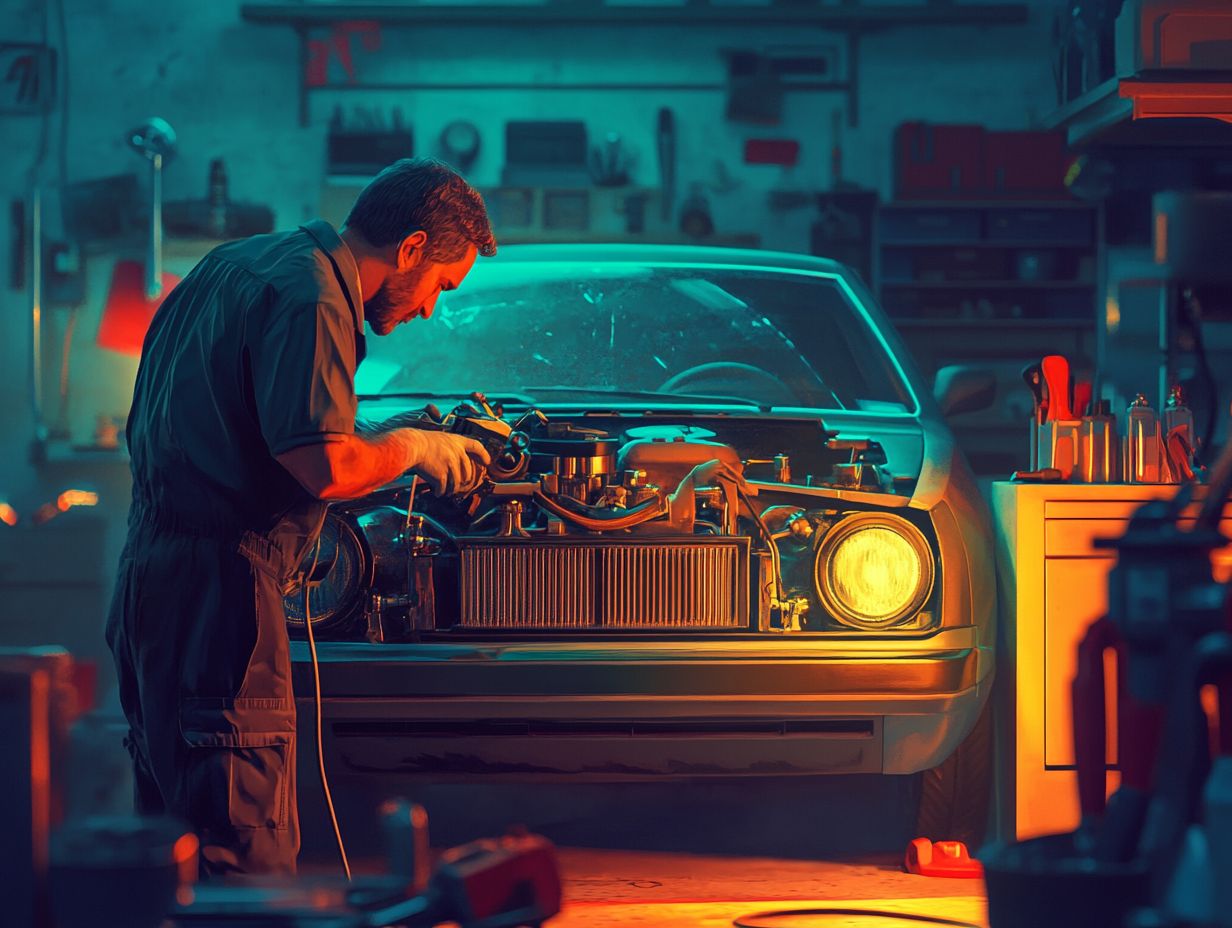
While tackling DIY maintenance can certainly be advantageous, there comes a time when professional cooling system maintenance becomes essential, particularly for complex problems that demand expert knowledge and specialized tools.
Mechanics at esteemed service stations, such as HEART Certified Auto Care in Chicago or Colonial Service Station in Staten Island, are equipped to conduct thorough inspections and provide services that guarantee your cooling system operates flawlessly.
Rely on experts to save you time and spare you from future headaches!
When to Seek Professional Help
Knowing when to seek professional assistance for your cooling system can greatly enhance your vehicle’s health. If you notice persistent overheating, coolant leaks, or any unusual noises, it s time to visit a trusted service station.
Skilled mechanics can provide thorough inspections and necessary repairs. Ignoring these warning signs can lead to severe and costly damage, including potential engine failure.
For instance, if your vehicle struggles to maintain its operating temperature, it may indicate a failing thermostat or a clogged radiator issues that definitely require expert evaluation.
An experienced technician not only pinpoints immediate problems but also offers steps to stop issues before they happen to protect against future complications. This is especially vital for those who depend on their vehicles daily, ensuring both longevity and reliability.
Seeking timely professional intervention ultimately saves you both time and money in the long run.
Tips for Maintaining Your Cooling System
By implementing effective strategies for maintaining your cooling system, such as following a guide to maintain your car’s climate control, you can significantly reduce the risk of overheating while enhancing your vehicle’s performance.
Regularly checking coolant levels, cleaning out old coolant, and inspecting crucial components such as hoses and belts are preventative measures that every discerning car owner should prioritize.
Preventive Measures and Best Practices
Adopting preventive measures and best practices for your vehicle’s systems can significantly enhance your driving experience and boost reliability. For example, knowing how to maintain your car’s exhaust system is crucial for optimal performance.
Regularly inspect coolant levels, check for leaks, and ensure that belts and hoses are in excellent condition. You should consider flushing the cooling system periodically to clean out old coolant and eliminate any debris that might obstruct coolant flow.
Using a high-quality coolant, as recommended by the manufacturer, not only ensures optimal performance but also extends the life of your system.
Keep a close watch on the thermostat and radiator, as these parts are crucial for temperature control.
During seasonal maintenance checks, paying attention to these areas can help prevent unexpected breakdowns or overheating during extreme weather conditions.
By committing to these practices, you can enjoy peace of mind, knowing that your vehicle’s cooling system is functioning efficiently.
Frequently Asked Questions
-
What is a car’s cooling system and why is it important to maintain?
A car’s cooling system is responsible for regulating the engine’s temperature and preventing it from overheating. It is important to maintain because an overheating engine can cause serious damage and even result in a breakdown.
-
How often should I check and maintain my car’s cooling system?
It is recommended to check and maintain your car’s cooling system at least once a year or every 12,000 miles, whichever comes first. Additionally, if you want to ensure your vehicle runs smoothly, learn how to maintain your car’s fuel system and address any warning signs of a potential issue immediately.
-
What are some warning signs that my car’s cooling system needs maintenance?
Some warning signs include the temperature gauge rising above the normal range, steam coming from under the hood, strange smells, and unusual noises coming from the engine. If you notice warning signs like steam from under the hood, act fast to avoid costly damage!
Don’t wait! Schedule your cooling system check today to keep your car running smoothly!
What are the steps involved in maintaining a car’s cooling system?
Check and top off coolant levels regularly. Look for leaks or wear in hoses and connections.
Replace the thermostat if it s not functioning properly. Flush the system to clear any buildup or debris.
Can I maintain my car’s cooling system myself or should I take it to a mechanic?
If you have the right tools and confidence, you can maintain your vehicle’s cooling system yourself. However, if you’re unsure, visit a mechanic for proper service.
How can regular maintenance of my car’s cooling system save me money in the long run?
Regular maintenance saves you money! It prevents costly repairs and keeps your car running efficiently.

